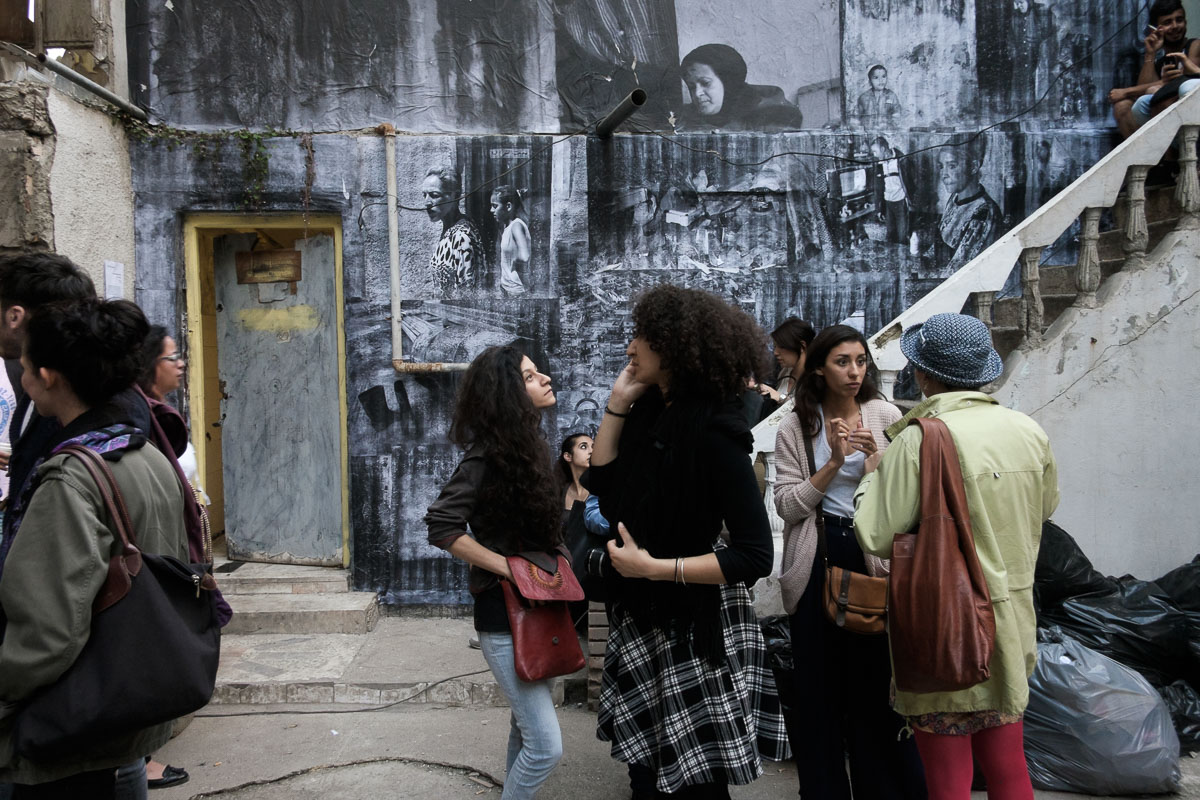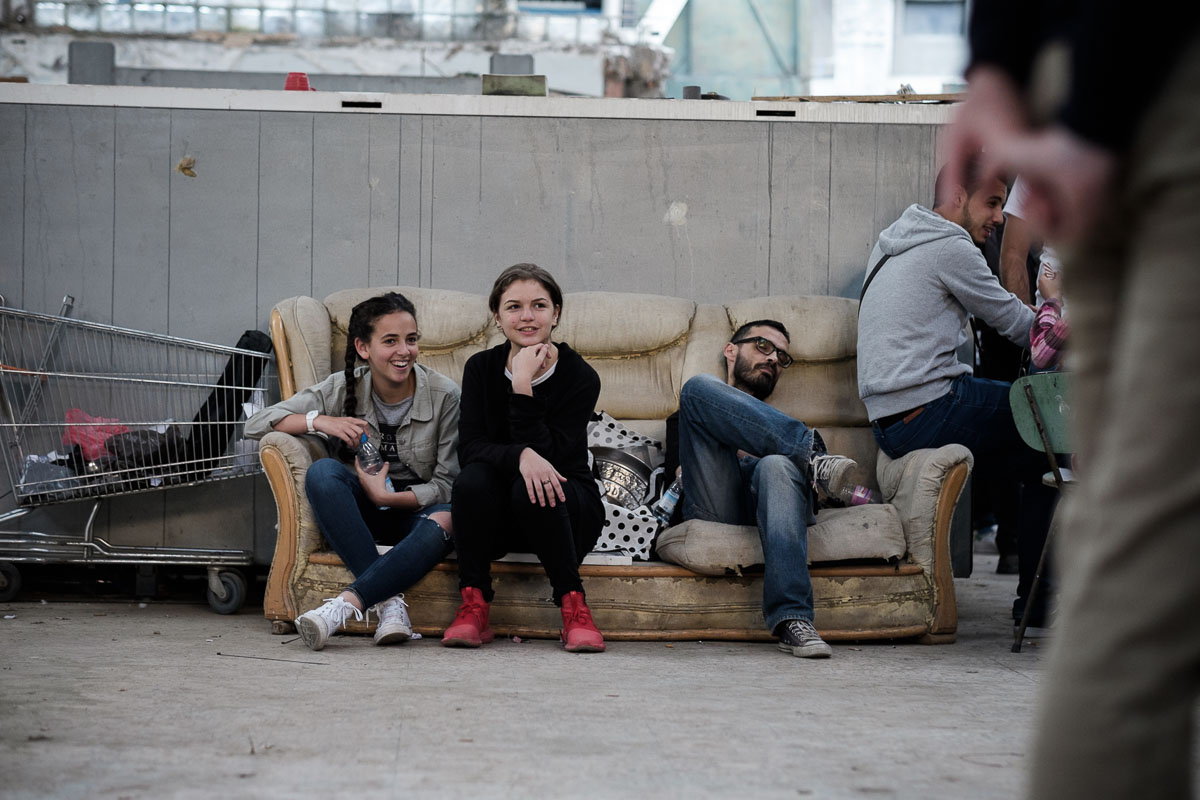New art in an old market
Picturie Générale III in Algiers

An abandoned old market in the middle of downtown Algiers – usually quiet and empty – has been turned into a collective space showing contemporary Algerian art.
From the outside, the big building just off Algiers’ main avenue Rue Didouche seemed as deserted as it’s been for many years. The walls were as anonymous, the ceiling as full with holes and openings. But from the narrow pavement leading past, a loud murmur of voices – a lot of them – could be heard. The old state-run marketplace, souk el fellah (and, before that, tramway station), was not empty today.
Inside was the opening of the third edition of Picturie Générale, an art initiative showcasing 23 contemporary Algerian artists from different media, including painting, video, photography and installation.
Around the corner and inside the old gates, a big open space appeared: brick walls and cement floors, high ceilings, light coming in from everywhere. While the place was once built for trams (and then transformed to store and display cheap market goods), on this breezy Sunday afternoon, it seemed the perfect urban gallery.
Questioning consumerism
One of the first works to meet the eye was a giant bag in a red and blue checkered pattern. The kind of bag with seemingly no limit to how much you can pack into it, but then has a quality that rarely survives more than one trip. Walid Bouchouchi, who creates art under the name Akakir did the bag as a symbol of our constant movement and exchange: belonging to no specific place or culture, but remaining essential in linking people together.

Next to the bag, with a similar kind of cross-border, recognisable expression, were Hicham Belhamiti’s empty potato sacks, hanging side by side with faces forming at the top ends. While pop art has always depicted the malaise of consumerism, Algerian society is not suffering from over-consumption, says Hicham Belhamiti: on the contrary, it is a place where people actually under-consume. In situations of scarcity like that, the one and only thing to rely on becomes the ever-cheap, iconic, potato.
In situations of scarcity like that, the one and only thing to rely on becomes the ever-cheap, iconic, potato.
Social critique
The exhibit does not gather artists around a particular theme, yet the collection as a whole, and each piece individually, delivers unmistakable social criticism. Fatima Chafaa portrays the plight of Algiers’ fishermen, hindered from fishing at the seashore by large barriers; Oussama Tabti shows photographs of abandoned gas stations and disused pumps, resembling carcases left behind by the economical wars fought in the region.

Then, probably more powerful than anything else in the exhibit, is the huge painting hanging from the roof: a Mediterranean boat filled with people, all painted in L’homme jaune’s trademark bright yellow. Walking around underneath, it felt like each step you took was guarded by the people above: as if their actions, their journey across the dangerous sea, had elevated them, lifted them above.

Photographed moments
In one corner, next to each other, hung photo series by two photographers: Arslane Bestaoui portraying women in Sidi el Houari, the old shaabi neighbourhood in Algeria’s second largest city Oran; and Youcef Krache with black and white images from Algiers, Tunis and Mali’s capital Bamako.
Each of Arslan Bestaoui’s photographs gives a glimpse into a world of well-known working class objects: colourful fabrics, satellite antennas, clothes hanging to dry on the roof. This is where the ladies of Sidi el Houari are cleaning, organising and caring for their families – tasks that traditionally are not seen as ‘work’, yet remained essential for each society to function. The beautiful thing with the photographs was how the women have this unmistakable air about them, an assertiveness and a kind of elegance, despite being in the midst of unglamorous work.

The women have this unmistakable air about them, an assertiveness and a kind of elegance, despite being in the midst of unglamorous work.
Youcef Krache, known in Algiers for his black-and-white street photography, had selected a series of 100 images, printed on normal paper and then pasted directly on the wall (the glue and roller were even left on the floor beneath). For him, it was not just a way to make the exhibit happen with little funds, it also adds an artistic dimension: literally taking the captured moments back to the city, to its walls, where you can touch them and feel the rugged texture. At the opening, someone had even ripped a piece of one of the images. “He came to ask if he could do that, I said sure – just pick the photo you like best!” says Youcef Krache with a smile.

No places to exhibit
While most visitors to the opening seemed to come with the exhibition in mind, the choice of place – a well-known, iconic, space right in the middle of the city – leaves the doors open to all Algiers’ residents. This is the idea: author Samir Toumi, one of the people behind Picturie Générale, says they want to “show the establishment and authorities what is possible to do.” Algiers, despite its size and numerous artist and creatives, lacks galleries and places to exhibit, and official support nearly always goes to well-established artists. “So we want to use places like this, there are so many empty spaces in the city. The guy who owns this building is young, only 37; he just agreed and gave us the keys when we asked about the space,” says Samir Toumi.
“We want to use places like this, there are so many empty spaces in the city.”

Behind him, attached to a string dangling from in the ceiling, hang a collection of football shoes in different sizes. To Mohamed Bourouissa, who is known for his work on youth and suburban culture, the shoes are at the same time global and hyper-local, representing both a globalised culture and that of young people in Algeria’s casbahs.
Then, the three pieces by Maya Benchikh El Fegoun, an artist who in her work continues to return to social topics and expressions in society. For this exhibit, she takes us through three dramatic rites of passage in the life of a child: circumcision, the first haircut and the first departure from the safety at home. Being a kid, her paintings remind us, is overwhelming and, on an emotional level, never really safe.
If the establishment – decision-makers, those with the power to outline the now and then of the city – should follow the path of the old tramways and the shoppers from 30 years ago, they would see not only Picturie Général bringing art to the urban setting, but also how artists can transform the way we think, act and live together in the city.


The exhibit is open on Rue Volta until May 21.







One thought on “New art in an old market”